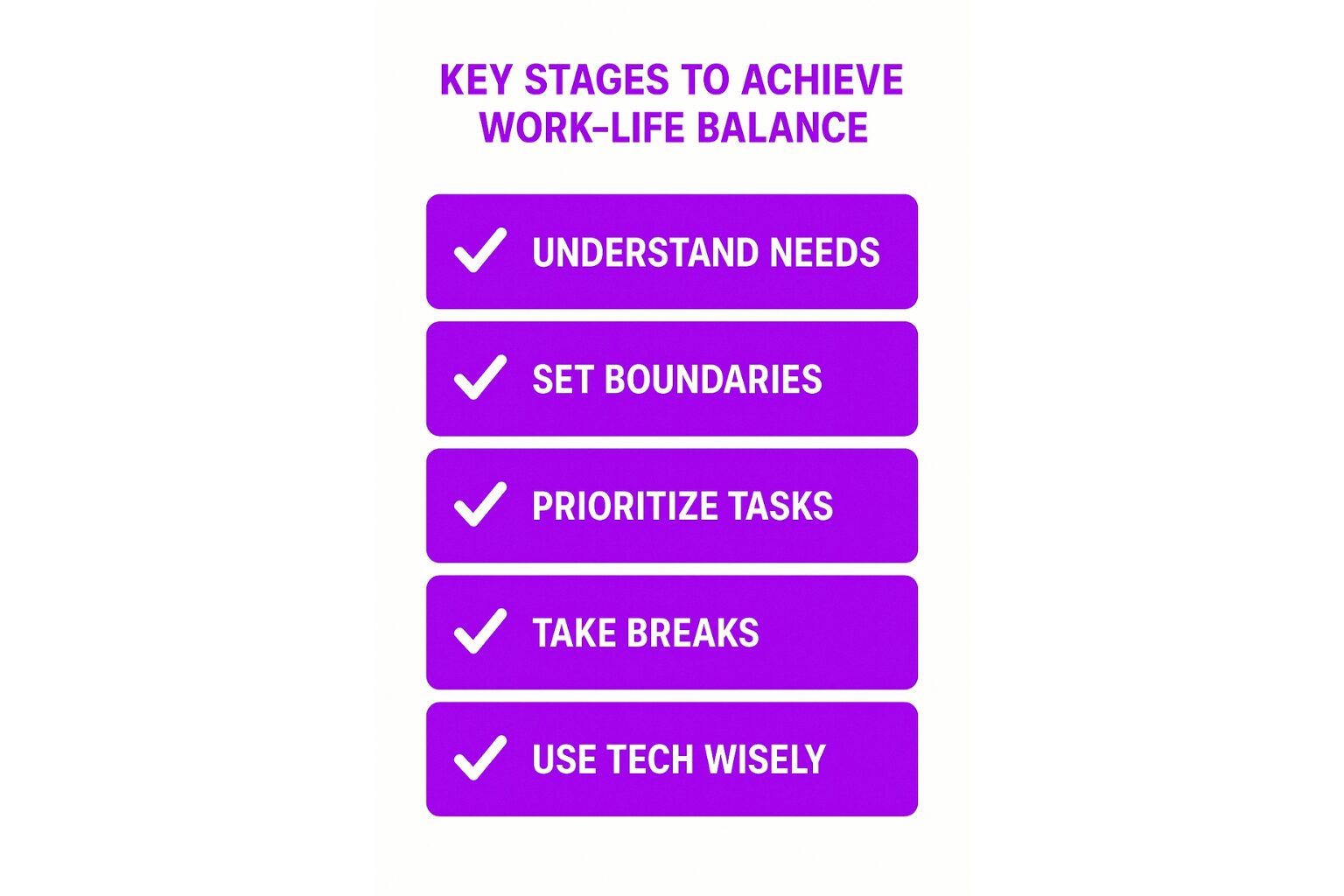What is Work-Life Balance?
Work-life balance refers to the concept of balancing the time and energy spent on work with the time dedicated to personal activities, relationships, and self-care. Achieving this balance means effectively managing professional and personal responsibilities so neither aspect overwhelms the other. Striking the right balance allows individuals to be productive at work while maintaining a healthy, fulfilling life outside of it. In today’s modern workforce, work-life balance has become a key consideration for both employees and employers, with growing recognition that personal well-being is integral to professional success. This makes work life balance important for achieving both professional success and personal fulfillment.
Comprehensive Explanation
Work-life balance is a fluid and personal concept, as what works for one individual may not work for another. For some, it might mean setting clear boundaries between work hours and personal time, while for others, it could mean integrating work tasks into their personal life to create more flexibility. To achieve work life balance, individuals can explore various strategies such as flexible work arrangements and personalized approaches to managing their responsibilities. The rise of remote work, flexible hours, and the increased availability of digital tools have all contributed to the evolution of work-life balance. In fact, these advancements have made it easier for many to blend personal and professional activities. However, for others, these changes blur the lines, making it harder to maintain separation between work and personal life.
Achieving a balance between work and personal life can reduce stress, prevent burnout, and improve overall well-being. It can also lead to greater job satisfaction, improved relationships, and higher productivity. For organizations, supporting employees in achieving work-life balance can result in a more motivated, engaged, and healthy workforce.
Work-Life Integration
While work-life balance suggests a strict separation between work and personal life, work-life integration takes a more flexible approach. It allows work and personal life to blend in a way that works for the individual. For example, someone may choose to answer emails during their lunch break or attend a personal appointment during the workday and make up the time later. Work-life integration acknowledges that life and work are interconnected, and that a rigid separation is not always feasible.
Key Stages of Achieving Work-Life Balance
1. Understanding Personal Needs
Achieving work-life balance begins with identifying personal needs and recognizing how work affects them. Balancing work and family life is crucial, as it allows individuals to manage their professional responsibilities while fulfilling family commitments. Individuals must assess their priorities—such as family, hobbies, health, and career goals—and determine how they can allocate time to these different areas. This self-awareness helps in making choices about where to direct attention and how to avoid work encroaching on personal life.
2. Setting Boundaries
Setting clear boundaries between work and personal life is essential to maintaining balance. Long work hours can negatively impact personal well-being, leading to stress, high blood pressure, and burnout. For some, this could mean leaving work at the office, while for others, it might involve setting time limits for when they will work or not work from home. These boundaries help employees protect their personal time, avoid burnout, and ensure that both their professional and personal lives are respected.
3. Prioritizing Tasks
Effective time management and task prioritization are crucial components of balancing personal and professional life. Learning how to prioritize responsibilities, both at work and at home, ensures that individuals can meet deadlines and goals without sacrificing their personal time. Techniques like the Eisenhower Matrix or time blocking can help individuals focus on what matters most, making it easier to allocate their time and energy efficiently.
4. Taking Breaks and Disconnecting
Regular breaks throughout the day—whether during work or in between personal tasks—help refresh the mind and reduce stress. Taking vacation days and completely disconnecting from work is also essential to recharge. Time away from work allows individuals to return with renewed focus and productivity.
5. Using Technology Wisely
In the digital age, technology can be both a blessing and a curse when it comes to work-life balance. While email, video calls, and project management tools can increase efficiency, they can also blur the lines between work and personal time. Learning to use these tools effectively—such as turning off notifications during personal time—can help individuals maintain their work-life balance.
Purpose and Importance of Work-Life Balance
1. Mental and Physical Health
One of the most critical reasons for maintaining a work-life balance is its direct impact on mental and physical health. Poor work life balance can lead to serious health issues and decreased productivity, as excessive work hours are linked to higher health risks and lower employee engagement. Long working hours, stress, and overwork can lead to burnout, anxiety, depression, and physical health issues like sleep problems, heart disease, and digestive disorders. By managing work and personal time effectively, individuals can prioritize self-care, stay healthy, and avoid chronic stress.
2. Improved Job Performance
When individuals are able to recharge and maintain their personal well-being, they return to work with renewed focus and energy. A healthy work-life balance leads to better concentration, increased efficiency, and higher quality work. In turn, this results in better job performance and more successful outcomes for the organization.
3. Employee Satisfaction and Retention
Employees who feel that they have a healthy work-life balance are more likely to be satisfied with their jobs and remain with the company. Flexible work hours, the ability to work remotely, and the encouragement of personal time off can increase job satisfaction and reduce turnover. Organizations that value their employees’ personal well-being foster loyalty and retention.
4. Stronger Relationships
Work-life balance allows employees to dedicate time to family, friends, and other relationships. Balancing professional life with personal relationships is crucial for achieving overall well-being and satisfaction. This balance strengthens personal connections and helps individuals maintain a strong support system, which can improve emotional resilience and reduce stress.
5. Benefits for Employers
Employers who support work-life balance can reap a multitude of benefits that positively impact their organization. Firstly, when employees maintain a healthy work-life balance, they are more focused and productive during work hours. This increased productivity translates into higher quality work and more efficient operations.
Moreover, employees who feel supported in their personal and professional lives are more likely to stay with their employer long-term, leading to improved employee retention. This loyalty reduces the costs and disruptions associated with high turnover rates.
Reduced absenteeism is another significant advantage. Employees with a good work-life balance are less likely to need time off for personal or family reasons, ensuring consistent workforce availability. Additionally, when employees feel valued and supported, their morale improves, fostering a positive work environment and enhancing overall job satisfaction.
Lastly, employers who offer work-life balance benefits become more attractive to potential employees. In a competitive job market, these benefits can be a key differentiator, helping organizations attract top talent and build a strong, committed workforce.
Benefits and Challenges of Work-Life Balance
Benefits
-
Higher Productivity: With better mental and physical health, employees are more focused, efficient, and creative in their work.
-
Reduced Stress: Employees who manage their time well between work and personal life tend to have lower stress levels, reducing the risk of burnout.
-
Greater Employee Loyalty: A company that values work-life balance fosters stronger loyalty, engagement, and job satisfaction.
-
Improved Creativity: Time away from work often leads to moments of reflection, which can enhance creativity and problem-solving abilities.
Challenges
-
Work Culture and Expectations: In some industries or companies, there may be a culture of overwork or unrealistic expectations that make it difficult for employees to maintain a healthy balance. This can significantly impact one’s personal life, making it challenging to prioritize both professional and personal demands.
-
Technological Pressures: Technology often makes it challenging for employees to truly disconnect, as they may feel pressured to respond to emails or messages outside of work hours.
-
Time Constraints: Balancing personal responsibilities—such as caregiving, household chores, or personal projects—with work can sometimes lead to time constraints, making it hard to prioritize relaxation and self-care.
Common Obstacles
Achieving a healthy work-life balance can be challenging due to several common obstacles. One major hurdle is long working hours, which can make it difficult for employees to find time for personal and family responsibilities. The pressure to work extended hours often leads to burnout and decreased productivity.
Technology, while beneficial, can also be a double-edged sword. The constant availability of digital communication tools makes it hard to disconnect from work, blurring the lines between professional and personal life. This perpetual connectivity can lead to increased stress and difficulty in maintaining a healthy work-life balance.
Another obstacle is the pressure to be constantly available. Some employers may expect employees to respond to work-related messages and requests outside of regular work hours, adding to the stress and making it hard to truly unwind.
Lack of support is also a significant barrier. Employees may not have access to the resources or assistance they need to manage their work and personal responsibilities effectively. This lack of support can exacerbate feelings of overwhelm and stress.
Personal circumstances, such as caring for a family member or managing a chronic illness, can further complicate the quest for a healthy work-life balance. These responsibilities require time and energy, making it challenging to juggle professional and personal demands.
Strategies for Overcoming Obstacles
Overcoming the obstacles to achieving a healthy work-life balance requires a proactive approach from both employees and employers. One effective strategy is setting clear boundaries around work hours and expectations. By defining specific times for work and personal activities, employees can protect their personal time and reduce work-related stress.
Prioritizing self-care is another crucial strategy. Engaging in activities such as exercise, meditation, and spending time with loved ones can help manage stress and maintain a healthy work-life balance. These activities promote mental and physical well-being, enabling employees to recharge and perform better at work.
Seeking support is also essential. Employees should not hesitate to reach out to their employer, colleagues, and family and friends for assistance in managing their responsibilities. A strong support system can provide the necessary resources and encouragement to maintain balance.
Using technology wisely can help mitigate its negative impact. Employees can set boundaries around their use of technology, such as turning off notifications during personal time and avoiding work-related activities outside of work hours. This approach helps create a clear separation between work and personal life.
Taking regular breaks throughout the day is another effective strategy. Short breaks can help manage stress and improve focus, while longer breaks, such as vacations, allow for complete disconnection from work and thorough rejuvenation.
Practical Tips and Best Practices
-
Establish Clear Work Hours and Boundaries
-
Set a clear start and end time for your workday, and avoid checking work emails or taking calls outside those hours.
-
-
Delegate and Prioritize
-
Don’t hesitate to delegate tasks, both at work and at home. Learn to prioritize your to-do list based on urgency and importance.
-
-
Make Time for Breaks
-
Take regular breaks during the day. A 10-minute walk or stretch can clear your mind and re-energize you. Similarly, ensure you take time off from work for vacations or extended breaks to refresh.
-
-
Use Technology Wisely
-
Use productivity tools to manage tasks and set reminders, but avoid being overwhelmed by constant connectivity. Turn off notifications during personal time.
-
-
Support from Leadership
-
Employers should encourage employees to maintain a healthy balance. This can include offering flexible working hours, remote work options, and recognizing the importance of personal time.
-
-
Foster a Culture of Balance
-
Encourage employees to take time off and set a good example by respecting personal boundaries and promoting the well-being of the workforce.
-
Self-Care and Wellness
Self-care and wellness are fundamental to maintaining a healthy work-life balance. Prioritizing self-care activities can significantly reduce stress and improve overall well-being. Regular exercise, for instance, is a powerful stress reliever that also enhances physical health. Whether it’s a morning jog, a yoga session, or a gym workout, incorporating physical activity into one’s routine can make a substantial difference.
Meditation and mindfulness practices are equally beneficial. These techniques help calm the mind, improve focus, and increase productivity. Even a few minutes of daily meditation can lead to significant improvements in mental health and well-being.
Spending time with loved ones is another critical aspect of self-care. Quality time with family and friends strengthens personal relationships and provides emotional support, which is essential for reducing stress and maintaining a balanced life.
Getting enough sleep is crucial for both physical and mental health. Adequate rest ensures that individuals are well-rested and ready to tackle the demands of their professional and personal lives. Prioritizing sleep can lead to better decision-making, improved mood, and enhanced overall well-being.
Lastly, maintaining a healthy diet is vital. Proper nutrition fuels the body and mind, helping individuals stay energized and focused. A balanced diet can improve physical health, boost immunity, and contribute to a better work-life balance.
By prioritizing self-care and wellness, employees can achieve a healthy work-life balance, leading to improved health, reduced stress, and greater overall well-being.
Related Sub-concepts
1. Work-Life Integration
-
Unlike work-life balance, which focuses on maintaining clear boundaries between work and personal life, work-life integration allows individuals to blend their professional and personal tasks. This concept is especially relevant for remote workers, where flexible schedules and blending tasks become part of the workday.
2. Employee Well-being
-
Employee well-being refers to the physical, mental, and emotional health of employees. Work-life balance plays a critical role in ensuring employees maintain their overall well-being, which contributes to their productivity and job satisfaction.
3. Flexible Work Arrangements
-
Flexible work arrangements, such as telecommuting, flexible hours, and job-sharing, allow employees to better manage their work-life balance. These arrangements are especially important for employees with caregiving responsibilities or those who need a flexible schedule.
Real-World Examples and Use Cases
1. Tech Companies Offering Flexible Hours
-
Many technology companies, such as Google and Microsoft, offer flexible working hours and remote work options, allowing employees to maintain a better work-life balance. These companies have found that employees are more productive and loyal when they are allowed to control their work schedules.
2. Healthcare and Work-Life Balance
-
Healthcare workers, especially during times of crisis like the COVID-19 pandemic, often face challenges in maintaining work-life balance. Many healthcare systems have started offering more flexible scheduling and support services to help reduce burnout and ensure that workers maintain mental and physical well-being.
3. Remote Work in Startups
-
Startups like Basecamp and Automattic have long been advocates for remote work and flexible schedules. They offer employees the autonomy to design their own workday, leading to increased satisfaction and a more balanced lifestyle.
Conclusion
Work-life balance is not just a buzzword; it’s a critical factor for improving personal well-being, boosting organizational productivity, and ensuring long-term job satisfaction. Achieving a healthy balance between work and personal life requires effort, both from individuals and organizations. By setting clear boundaries, prioritizing tasks, and embracing flexible work options, employees can reduce stress and avoid burnout, while organizations can foster a more engaged, loyal, and productive workforce.
The challenge of achieving work-life balance is real, but with the right strategies and a supportive culture, both employees and organizations can thrive in a modern, fast-paced work environment.







